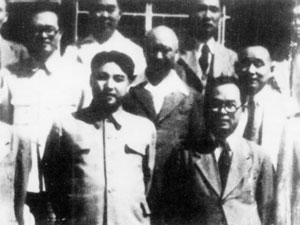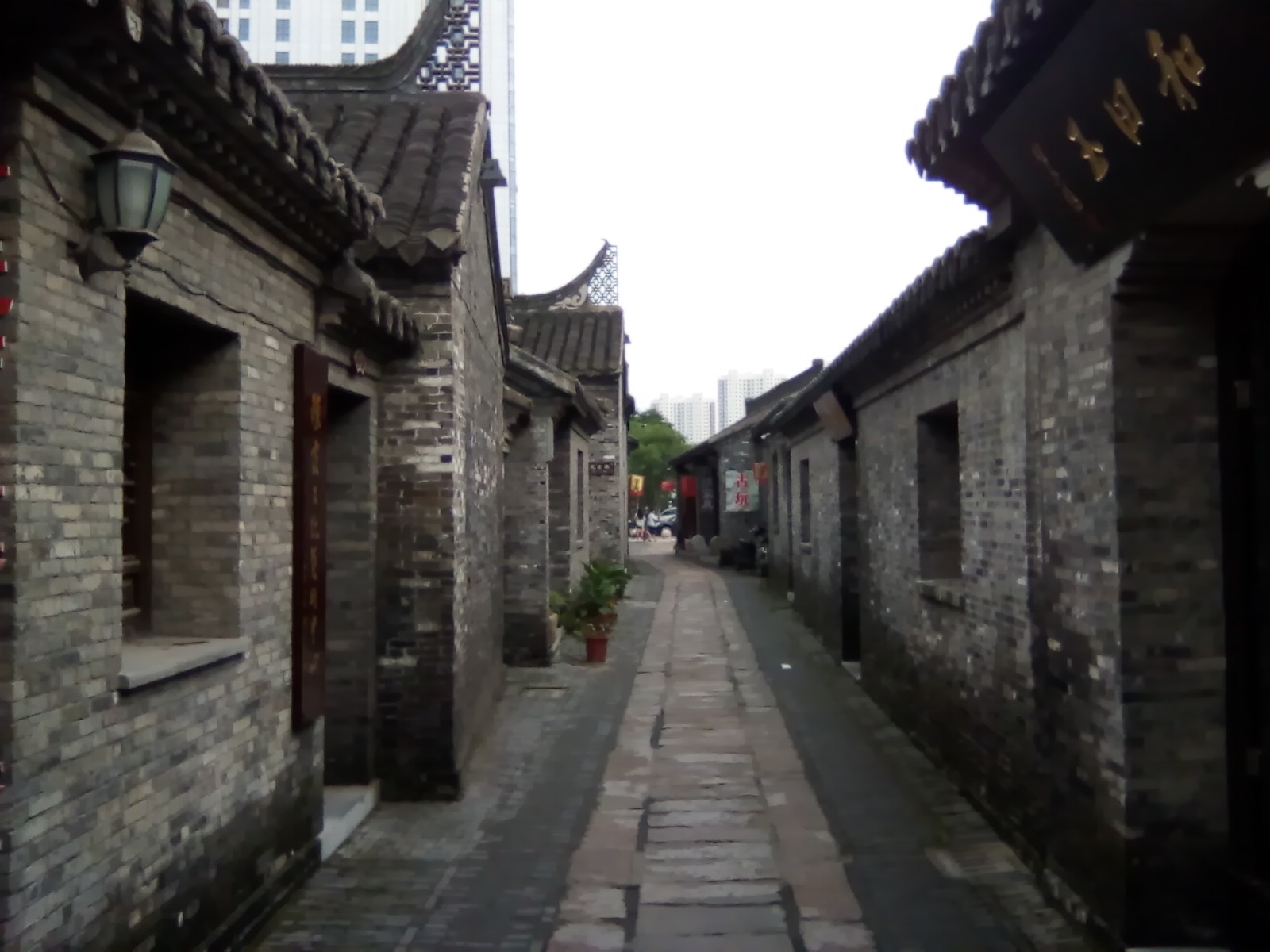|
Chinese Tunic Suit
The modern Chinese tunic suit is a style of male attire originally known in China as the Zhongshan suit () after the republican leader Sun Yat-sen (Sun Zhongshan). Sun Yat-sen introduced the style shortly after the founding of the Republic of China (1912–1949) as a form of national dress with distinct political overtones. He based the suit on the Japanese cadet uniform. The four pockets are said to represent the Four Virtues of propriety, justice, honesty, and shame; and the five buttons the branches of China's former government (Executive, Legislative, Judicial, Examination, Control), which still survive today in the Republic of China government of Taiwan. After the Communist victory in the Chinese Civil War and the establishment of the People's Republic of China in 1949, such suits came to be worn widely by male citizens and government leaders as a symbol of proletarian unity and an Eastern counterpart to the Western business suit. The name "Mao suit" comes from Chinese ... [...More Info...] [...Related Items...] OR: [Wikipedia] [Google] [Baidu] |
Workers' Party Of Korea
The Workers' Party of Korea (WPK) is the founding and sole ruling party of the Democratic People's Republic of Korea, commonly known as North Korea. Founded in 1949 from the merger of the Workers' Party of North Korea and the Workers' Party of South Korea, the WPK is the oldest active party in Korea. It also controls the Korean People's Army, North Korea's armed forces. The WPK is the largest party represented in the Supreme People's Assembly and coexists with two other legal parties making up the Democratic Front for the Reunification of Korea. However, these minor parties are completely subservient to the WPK and must accept the WPK's "Vanguard party, leading role" as a condition of their existence. The WPK is banned in South Korea (Republic of Korea) under the National Security Act (South Korea), National Security Act and is sanctioned by the United Nations, the European Union, Australia, and the United States. Officially, the WPK is a communist party guided by Kimilsungism� ... [...More Info...] [...Related Items...] OR: [Wikipedia] [Google] [Baidu] |
Hu Jintao
Hu Jintao (born 21 December 1942) is a Chinese politician who served as the 16–17th general secretary of the Chinese Communist Party (CCP) from 2002 to 2012, the 6th president of the People's Republic of China (PRC) from 2003 to 2013, and chairman of the Central Military Commission (CMC) from 2004 to 2012. He was a member of the CCP Politburo Standing Committee, China's ''de facto'' top decision-making body, from 1992 to 2012. Hu was the paramount leader of China from 2002 to 2012. Hu rose to power through the Chinese Communist Party (CCP), notably as Party Committee secretary for Guizhou province and the Tibet Autonomous Region, where his harsh repression of dissent gained him attention from the highest levels. He moved up to first secretary of the CCP Central Secretariat and vice president under CCP general secretary Jiang Zemin. Hu was the first leader of the Communist Party from a generation younger than those who participated in the civil war and the founding of ... [...More Info...] [...Related Items...] OR: [Wikipedia] [Google] [Baidu] |
Neckties
A necktie, or simply a tie, is a piece of cloth worn for decorative purposes around the neck, resting under the shirt collar and knotted at the throat, and often draped down the chest. Variants include the ascot, bow, bolo, zipper tie, cravat, and knit. The modern necktie, ascot, and bow tie are descended from the cravat. Neckties are generally unsized but may be available in a longer size. In some cultures, men and boys wear neckties as part of office attire or formal wear. Women wear them less often. Neckties can also be part of a uniform. Neckties are traditionally worn with the top shirt button fastened, and the tie knot resting between the collar points. History Origins The necktie that spread from Europe traces back to Croatian mercenaries serving in France during the Thirty Years' War (1618–1648). These mercenaries from the Military Frontier, wearing their traditional small, knotted neckerchiefs, aroused the interest of the Parisians. Because of the differe ... [...More Info...] [...Related Items...] OR: [Wikipedia] [Google] [Baidu] |
Jiang Zemin
Jiang Zemin (17 August 1926 – 30 November 2022) was a Chinese politician who served as general secretary of the Chinese Communist Party (CCP) from 1989 to 2002, as chairman of the Central Military Commission from 1989 to 2004, and as president of China from 1993 to 2003. Jiang was paramount leader of China from 1989 to 2002. He was the core leader of the third generation of Chinese leadership, one of only four core leaders alongside Mao Zedong, Deng Xiaoping and Xi Jinping. Jiang Zemin came to power unexpectedly as a compromise candidate following the 1989 Tiananmen Square protests and massacre, when he replaced Zhao Ziyang as CCP general secretary after Zhao was ousted for his support for the student movement. At the time, Jiang had been the party leader of the city of Shanghai. As the involvement of the "Eight Elders" in Chinese politics steadily declined, Jiang consolidated his hold on power to become the "paramount leader" in the country during the 1990s. Urged by D ... [...More Info...] [...Related Items...] OR: [Wikipedia] [Google] [Baidu] |
General Secretary Of The Communist Party Of China
The general secretary of the Chinese Communist Party () is the head of the Chinese Communist Party (CCP), the sole ruling party of the People's Republic of China (PRC). Since 1989, the CCP general secretary has been the paramount leader of the PRC. Overview According to the Constitution of the Chinese Communist Party, the general secretary serves as an ''ex officio'' member of the Politburo Standing Committee, China's ''de facto'' top decision-making body. The general secretary is also the head of the Secretariat. Since 1989, the holder of the post has been, except for transitional periods, the Chairman of the Central Military Commission, making the holder the supreme commander of the People's Liberation Army. The position of general secretary is the highest authority leading China's National People's Congress, State Council, Political Consultative Conference, Supreme People's Court and Supreme People's Procuratorate in the Chinese government. As the top leader of th ... [...More Info...] [...Related Items...] OR: [Wikipedia] [Google] [Baidu] |
Deng Xiaoping
Deng Xiaoping (22 August 1904 – 19 February 1997) was a Chinese revolutionary leader, military commander and statesman who served as the paramount leader of the People's Republic of China (PRC) from December 1978 to November 1989. After CCP chairman Mao Zedong's death in 1976, Deng gradually rose to supreme power and led China through a series of far-reaching market-economy reforms earning him the reputation as the "Architect of Modern China". He contributed to China becoming the world's second largest economy by GDP nominal in 2010. Born in the province of Sichuan in the Qing dynasty, Deng studied and worked in France in the 1920s, where he became a follower of Marxism–Leninism and joined the Chinese Communist Party (CCP) in 1924. In early 1926, Deng travelled to Moscow to study Communist doctrines and became a political commissar for the Red Army upon returning to China. In late 1929, Deng led local Red Army uprisings in Guangxi. In 1931, he was demoted within the ... [...More Info...] [...Related Items...] OR: [Wikipedia] [Google] [Baidu] |
Generations Of Chinese Leadership
Generations of Chinese leadership is a term historians use to characterize distinct periods of the leadership of the Chinese Communist Party (CCP) and, by extension, successive changes in the ideology of the CCP. Historians have studied various periods in the development of the government of the People's Republic of China by reference to these "generations". Terminology While in English the chronological leadership groups are commonly referred to as "generations of Chinese leadership", there is no exact equivalent expression in Chinese. The usual term in official discourse for such a group is a "leadership collective", which are counted in generations. Thus, for example, the "first generation" of leaders identified below are labelled as "the first generation leadership collective". In official discourse, they are also not viewed as leaders of the ''state'' (the People's Republic of China), but rather leaders of the ''party'' (the CCP). In the CCP's official discourse, the "ge ... [...More Info...] [...Related Items...] OR: [Wikipedia] [Google] [Baidu] |
Han Chinese
The Han Chinese () or Han people (), are an East Asian ethnic group native to China. They constitute the world's largest ethnic group, making up about 18% of the global population and consisting of various subgroups speaking distinctive varieties of the Chinese language. The estimated 1.4 billion Han Chinese people, worldwide, are primarily concentrated in the People's Republic of China (including Mainland China, Hong Kong and Macau) where they make up about 92% of the total population. In the Republic of China (Taiwan), they make up about 97% of the population. People of Han Chinese descent also make up around 75% of the total population of Singapore. Originating from Northern China, the Han Chinese trace their cultural ancestry to the Huaxia, the confederation of agricultural tribes living along the Yellow River. This collective Neolithic confederation included agricultural tribes Hua and Xia, hence the name. They settled along the Central Plains around the middle and lo ... [...More Info...] [...Related Items...] OR: [Wikipedia] [Google] [Baidu] |
Qing Dynasty
The Qing dynasty ( ), officially the Great Qing,, was a Manchu-led imperial dynasty of China and the last orthodox dynasty in Chinese history. It emerged from the Later Jin dynasty founded by the Jianzhou Jurchens, a Tungusic-speaking ethnic group who unified other Jurchen tribes to form a new "Manchu" ethnic identity. The dynasty was officially proclaimed in 1636 in Manchuria (modern-day Northeast China and Outer Manchuria). It seized control of Beijing in 1644, then later expanded its rule over the whole of China proper and Taiwan, and finally expanded into Inner Asia. The dynasty lasted until 1912 when it was overthrown in the Xinhai Revolution. In orthodox Chinese historiography, the Qing dynasty was preceded by the Ming dynasty and succeeded by the Republic of China. The multiethnic Qing dynasty lasted for almost three centuries and assembled the territorial base for modern China. It was the largest imperial dynasty in the history of China and in 1790 the f ... [...More Info...] [...Related Items...] OR: [Wikipedia] [Google] [Baidu] |
Changshan
(; ), also known as (), and (), is a form of , Chinese robe, which was derived from the Qing dynasty , the traditional dress of the Manchu people, which were worn by Manchu men. The was actually developed by the Han Chinese through the modification of their own Ming dynasty's by adopting some Manchu men's clothing elements in one of their . In function, the is considered the male equivalent of the women's ''cheongsam'' (also known as '). The was often worn by men with a , also commonly translated as "riding jacket" in English language. Terminology General term The term is composed of two Chinese characters: 《》which can literally be translated as "long" in length and 《》, which literally means " shirt". The term is also composed of the Chinese character and the Chinese 《》, which is literally means "robe". As general terms used in the broad sense, the and can refer to any form of long shirt and long robes respectively. Specific term The Mandarin ... [...More Info...] [...Related Items...] OR: [Wikipedia] [Google] [Baidu] |





.jpg)
